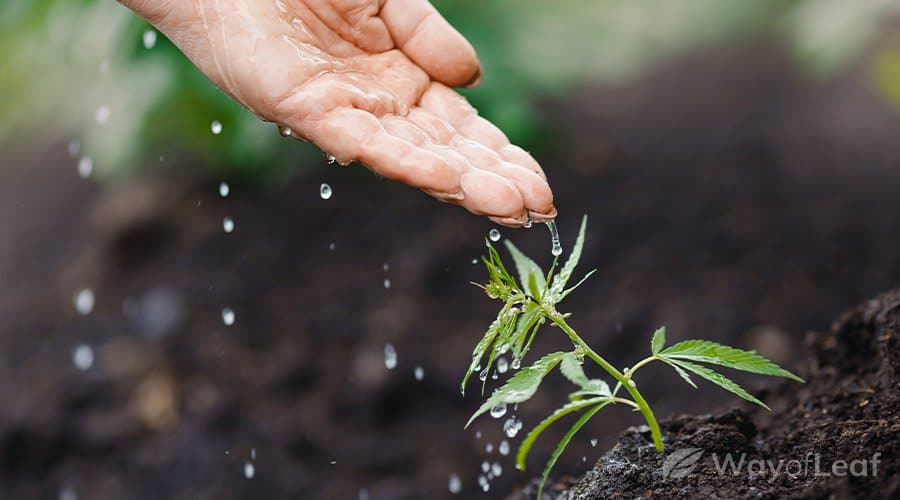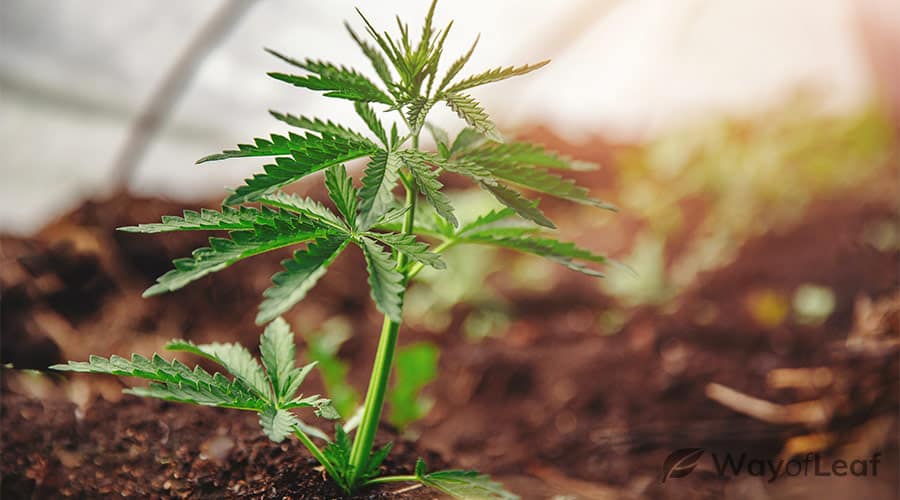Not all types of marijuana plant stress are ‘bad.’ You can introduce ‘good’ types of stress during the growing cycle, which helps create robust plants that produce larger buds and more resin. The best plants can survive doses of this ‘good’ stress and thrive. For example, using air circulation wisely can work wonders. If you use an oscillating fan to keep plants moving with forced air, you provide small stresses to the plant’s stem, which help it become thicker and stronger.
However, ‘bad’ stress is a major concern because it affects the plant’s normal function. When your plant is exposed to negative stress, it can adversely impact its yield, increase its susceptibility to pest and disease attacks, and limit its ability to absorb the light it needs for photosynthesis. Excessive exposure could kill your marijuana plants!
If this is your first time growing a marijuana plant, get prepared for a lot of hard work. The health of your crop is determined by the environment you grow it in. Factors such as humidity, air quality, light, and temperature determine whether you will have a healthy crop with a bumper yield or not.
Stress can also result in ‘hermaphrodite’ plants. When marijuana plants have both genders, they can pollinate themselves and other plants in the vicinity. All it takes is one hermaphrodite plant to ruin an entire crop because it can pollinate a room! Ultimately, pollinated plants produce low-quality buds. If you’re concerned about your marijuana crop, keep reading to discover five ways to prevent plant stress.
1 – Prevent Light Cycle Interruption
The marijuana plant is pretty tough and can survive in a wide range of conditions. However, it definitely won’t thrive in an unsuitable growing environment. For instance, your weed is very sensitive to changes in its light cycle because this is how it knows that the seasons are changing. If you alter the ideal schedule and intensity of light exposure, it will stress your marijuana plant.

This is less of an issue for outdoor growers because you are offering natural light exposure. However, indoor growers must maintain strict light schedules for their plants, which change during the different growth stages. For example, you must provide 18–24 hours of light for marijuana plants during the vegetative stage. During the flowering stage, switch to a 12 hours of light, 12 hours of complete darkness schedule.
Also, make sure you design your indoor lighting to provide the right level of exposure. Placing your lights too far away from, or too close to, your plants can cause stress. One of the big dangers of growing cannabis indoors is that buds near the bottom of the plant don’t receive enough light.
2 – Maintaining the Ideal Temperature & Humidity in the Growth Environment
Marijuana plants will become stressed in any grow room where the temperature is too hot or cold and if they are exposed to excessive humidity. The tricky part, especially for indoor growers, is to be aware of the right temperature and humidity ranges during all of your marijuana plant’s growth stages.
Seedlings:
- Humidity of 65-70%.
- Temperature range of 68 – 76 degrees Fahrenheit.
- Reduce temperature by 5-8 degrees during lights off.
- You need a high level of humidity to ensure that your seedling can consume water via its leaves.
Vegetative Stage:
- Lower the humidity level by 5% weekly, but ensure your plant grows in a humidity range of between 40% and 70%.
- You can keep the temperature range at 70 – 80 degrees Fahrenheit.
- Reduce temperature by 5 – 8 degrees during lights off.
- At this time, the plant’s roots can absorb more water, and evaporation through the leaves cools the plant.
Flowering Stage:
- Reduce humidity levels to 40 – 50%. Anything over 60% is extremely bad and will stress your plants.
- Temperature range of 68 – 78 degrees Fahrenheit.
- The lower end of the temperature scale is advisable during flowering.
Two Weeks Before Harvest:
- Drop humidity so that is in the 30 – 40% range.
- Reduce temperature range to 65 – 75 degrees Fahrenheit.
- Drop the temperature by 5 – 10 degrees during lights off.
If the humidity level is too high at any stage, invest in a dehumidifier and water your plants directly after switching the lights on. Increase humidity by using a spray bottle on your plants, ensuring the soil’s surface is moist (not wet) and buying a humidifier.
Reduce temperatures by increasing total airflow in the room, ensuring the lights are off during the day, and installing an air conditioning unit. Increase temperature by upgrading to larger grow lights, or by adding a heating mat at the bottom of your grow room.
Overheated plants can experience heat stress, which may lead to permanent damage. Plants exposed to excessively low temperatures can sometimes display unusual traits, such as turning purple.
3 – Water Your Plants Correctly
It is normal for new growers to become overenthusiastic and water their marijuana plants too frequently. After all, the plant is 80% water, and it needs liquid to transport its nutrients throughout the plant. Unfortunately, we can’t provide you with a ‘generic’ watering guide because differences in geographical location dictate the amount of water a plant needs.
For example, a plant in a cool climate may only need two liters of water every three days. In a warm climate, the same plant might need two liters a day because the sun dries it out. Also, fast-draining soil needs more water than clay soil, for example. Before determining a watering cycle, check the drainage of the soil by digging a 12-inch hole and pouring water into it. The soil offers very bad drainage if the water is not fully drained within an hour.

Ultimately, you have to look for certain signs provided by the plant rather than following a basic guide. For instance, check the lower foliage regularly. If it shows reduced resistance or is starting to look ‘slack,’ it’s a sign that the plant needs watering. Check the soil to a depth of 5 cm. If any part of it feels dry, water slowly until the soil feels moist, but don’t water to the point where it is saturated.
For best results, use lukewarm water because it doesn’t shock the roots and soaks into the soil easily. Use water with a pH between 5.6 and 5.8 during vegetation and between 6 and 6.2 during flowering. For reference, clear rainwater has a pH of 5.6. The risk of overwatering is more prevalent when you use poor-draining soils such as clay. Check regularly to make sure you don’t excessively water your plant; otherwise, you will prevent the root system from getting the oxygen it needs.
4 – Get the Nutrient Balance Right
Another common cause of plant stress is providing too many or too few nutrients. Nutrient stress can cause problems such as spotted and discolored leaves or stunted growth. Offering excessive nutrients attracts pests, especially bugs, that will destroy your crop if left unchecked.
Nitrogen (N), Phosphorus (P) and Potassium (K), are the three main nutrients you need to be concerned with. When you purchase plant nutrients, you will normally see an N-P-K ratio. If you are using premium-quality soil, allow the cannabis plant to use up the soil’s nutrients for the first three weeks or so before adding anything else.
Once your plant begins opening its first leaves, use a nutrient formula that is high in nitrogen and potassium. When it reaches the flowering stage, you’ll need more phosphorus, high potassium, and a lower level of nitrogen. P tends to increase the number of flowers, and K increases the weight of the flowers. Too much N during the flowering stage could result in reduced bud development, not to mention an unpleasant taste.
5 – Maintaining the Right pH Level in Your Soil
The soil you choose will have a profound effect on how your crop turns out because it is your plant’s frame. Loam soil is the best option because it is a combination of sand (less than 52%), silt (between 28% and 50%), and clay (a maximum of 27%). Loam soil typically drains well, allows room for air to mix into it, and provides the best yield.
Even so, you have to ensure the pH of your loam soil is perfect, or else your crop will suffer. The pH of the soil determines how acidic or alkaline it is. If the soil’s pH is at the wrong level, your plant’s roots won’t be able to absorb all its nutrients and will begin showing signs of nutrient stress. On the pH scale, 7.0 is considered the mid-range; a higher number means alkaline and a lower number means acidic.
In general, cannabis plants need soil with a pH of between 6.0 and 6.5, which is slightly on the acidic side. However, if you are using hydroponics, the ideal pH level drops to between 5.5 and 6.5. As well as checking the pH of the soil, always make sure you read the pH level of the nutrient solutions you add before watering.
Final Thoughts on Preventing Marijuana Plant Stress
Overall, avoid ‘extremes’ in your growing environment. This guide has pointed you in the right direction regarding the ideal temperature, humidity, pH, nutrients, water, and light levels. As they are general guidelines, there is a pretty broad range to consider.
Even if you follow the above instructions to the letter, you must regularly monitor your plants for signs of stress. The sooner you identify the stress, the sooner you can determine the cause and make the changes. Don’t take too long; otherwise, the size of the harvest, the quality of the bud, and even the taste of your weed will be negatively affected.




![8 Tips for Growing NYC Diesel Marijuana [Grower’s Guide]](https://wayofleaf.com/wp-content/uploads/2019/01/wol-banner-8-tips-for-growing-nyc-diesel-marijuana-640x225.jpg)



![Grow Bigger Cannabis Buds Outdoors and Indoors [FIND OUT HOW]](https://wayofleaf.com/wp-content/uploads/2018/09/mj_how-to-grow-bigger-cannabis-buds_1920-640x225.jpg)

![Drying and Curing Cannabis Buds [The Easy Guide]](https://wayofleaf.com/wp-content/uploads/2018/07/drying-and-curing-cannabis-buds-1-640x225.jpg)
![Why Are My Cannabis Leaves Turning Yellow? [Explained]](https://wayofleaf.com/wp-content/uploads/2020/08/wol-banner-why-are-my-cannabis-leaves-turning-yellow-640x225.jpg)
